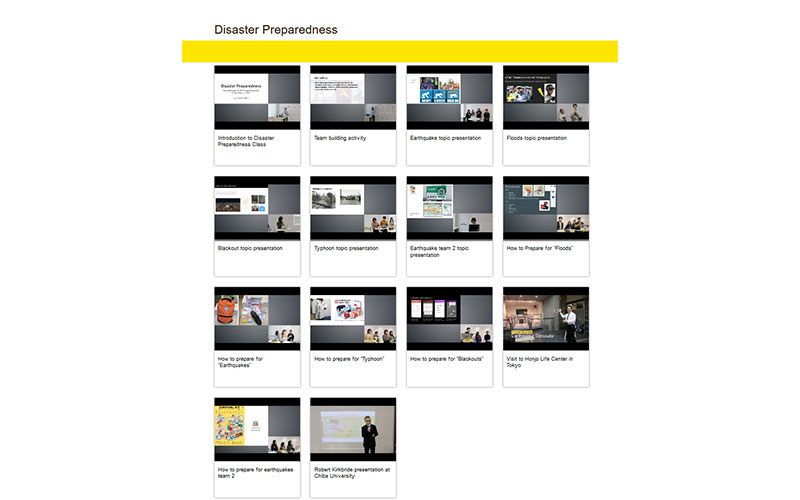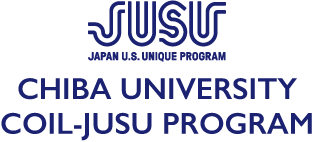Disaster Preparedness

実施大学(学部)
Partner university (faculty)
千葉大学工学部 国際教養学部 ニュースクール大学
Faculty of Engineering, College of Liberal Arts and Sciences, Chiba University and The New School
授業日程
Class schedule
千葉大学工学部 国際教養学部
Faculty of Engineering, College of Liberal Arts and Sciences, Chiba University
T4-T5 水曜3限
Term 4-5, Wednesday, 3rd Period
ニュースクール大学
The New School
January-May 2020 at Parsons
時差
Time difference
13時間
13 hours
授業目的
Class objectives
千葉大学工学部 国際教養学部
Faculty of Engineering, College of Liberal Arts and Sciences, Chiba University
The purpose was to research and learn about the following topics and areas:
- The most common natural disasters in the U.S. & Japan
- Emergency Management (Mitigation, Preparedness, Response and Recovery)
- Applications of Design and Technology in Emergency and Survival During Natural Disasters
The task was to create product or/and service design for Emergency and Survival During Natural Disasters.
ニュースクール大学
The New School
Purpose of class
The program has been designed to facilitate discussion through different lenses, emotionally, functionally and socially. The class is broken up into 3 projects over the semester:
Through a series of mini lectures/conversation and panel discussions that invite firsthand experiences and professionals who work in the area of disaster relief to expose our students to different stakeholders in disaster preparation. Students interrogate ideas of disaster preparation, isolate areas of opportunity and give solutions where they must argue why their solution is important.
授業内容
Class content
千葉大学工学部 国際教養学部
Faculty of Engineering, College of Liberal Arts and Sciences, Chiba University
Disaster Preparedness Class (Term 4 & Term 5):
October 2019 - Disaster Preparedness Class started.
Exchange students and Chiba University students were divided according to their interests into the following teams: Earthquake First Team, Earthquake Second Team, Floods Team, Power Blackouts Team and Typhoon Team.
November 2019. Chiba University teams did their individual research about the most common natural disasters in Japan and applications of design and technology in emergency and survival during natural disasters. Videos of team presentations were prepared.
December 2019. Lectures by academic staff. Field trip to Honjo Life Safety Learning Center. Brainstorming and selection of new concepts and ideas.
January 2019. Development of concepts of products, services and Apps.
Visit by Robert Kirkbride, Dean of SCE & Professor of Architecture and Product Design. Students met Robert Kirkbride and received comments.
February 2019. Preparation for presentations. Videos of Final presentation were prepared.
Visit by Hirokazu Nagata, Chairperson of "+arts" (Plus Arts) and Director of KIITO|Design and Creative Center Kobe on 5th February 2020.
Students met Hirokazu Nagata and received comments.
Trip to New York and visit to Parsons Scholl of Design by 7 students from Chiba University during 21st-29th February 2020.
ニュースクール大学
The New School
Content of the class
(SPRING 20 - 15 weeks semester)
The semester is broken up into 3 different projects.
Project 1
Local
Personal Disaster Plan
Many of us have experienced disasters in one form or another. We are noticing more frequently the effects that manmade and environmental changes are having on our planet. In creating safety, we are trained to think of our own safety first before helping others. In the spirit of this theme, design a personal disaster plan.
How can the design of this product (artifact or/and system) facilitate health and wellness in a disaster scenario for yourself and how can this design be applied to your family?
Project 2
Local
Group Project 2
Social/Functional/Emotional
Argument - Why is your solution important?
New York City has been affected and has had to respond to disasters in its history. From terrorism like 9/11, to city wide blackouts in 1977 and 2003, and natural disasters like Hurricane Sandy in 2012, disasters have left a scar on the city. New York has had to evolve and change to adapt to these ongoing threats. Looking through the lens of Social, Functional or Emotional, propose a design solution that argues why it is important. When selecting your area of focus, consider previous disasters NYC has undergone to help you create a new plan, product and focus.
Project 3
International
The Different Forms of Water
Teams
It has been said that water is the next commodity that wars will be fought over. Looking at current affairs at large, it seems that water disasters exists in many ways. Water in abundance or scarcity, it could be argued that issues also in question are conversations of cultural destruction of memory, migration, air quality, and biodiversity to name a few.
授業実施形態
Class format
非同期型
Asynchronous
使用ツール
Tools used
Knovio
千葉大学工学部 国際教養学部
Faculty of Engineering, College of Liberal Arts and Sciences, Chiba University
During the Term 4, videos of students' presentations about tsunami, earthquake, floods, power blackouts and typhoon were prepared and uploaded on Knovio.
In the end of Term 5, five different concepts were presented and recorded:
- A prototype of game with VR experience to teach people how to handle themselves in a flood disaster situation.
- Preparedness Week is a system and campaign to motivate citizens to prepare for disasters.
- Kit-Care is a set of items as a gift. The set of items includes: food, saver, tool and information.
- Shake-Shake is a prototype of interactive game helping to teach people how to behave during the earthquake.
- Shelter Search is an application (app) helping to find the nearest shelter and proving the information about the congestion of shelters and evacuation routes.
All videos are available on Knovio for Chiba University and Parsons students.
The uploaded and updated videos will be used for online learning during the next academic year.
To engage audience, we tested different pre-recorder video presentation formats: Experts' presentations and comments (Hirokazu Nagata and Robert Kirkbride), Video of activities at Honjo Life Safety Learning Center, various students' presentations in front of screen or with integrated presentation slides.
The best format will be revealed later after checking the final number of views.
The last visit to Parsons School of Design helped to develop the connection between students and academic staff. As a result, it made the online communication easier.
ニュースクール大学
The New School
Notable Initiatives and Results for Online Collaborative Learning
Disaster Preparation in 2020
Public Panel Discussion
Disaster is, by definition, an ill-starred event. Whether caused by natural or human-made conditions, disasters are increasing in frequency and magnitude, often dominating world headlines and testing our resilience. There is an opportunity for design to better prepare not only ourselves but also include global biodiversity in our approach.
In this panel discussion, we are viewing disaster preparation through Social, Functional and Emotional lenses.
Our guests include:
Dr. Mari Morimoto - Emotional
Dr. Mari Morimoto is a small animal veterinarian and member of the Veterinary Medical Association of New York City, who has served on its Executive Board with a core member of the New York City Veterinary Emergency Response Team (NYC-VERT), a volunteer group of vets and animal health professionals dedicated to the support of New York City's working and companion animals in times of disaster. She has experienced several calamities herself, most notably 9/11, the 3/11 earthquake, and Hurricane Sandy.
Glenny Rodriguez - Social
Glenny Rodriguez from FEMA in the role of Supervisor for the Mitigation Program Management Branch, in the Federal Emergency Management Agency's Region 2. She leveraged her architectural background and started working as a Public Assistance Mitigation grants project manager. She has managed some of FEMA's highly technical and complex multi-billion-dollar mitigation projects under Hurricane Sandy. Was deployed to Puerto Rico to assist and train local hire in PA Mitigation grant program for Hurricane Maria 2017 and currently supervises the Mitigation Division's Program Management Branch responsible for the Division's data analytic capability across the various Mitigation Branch and Grant Programs. Her involvement in the implementation of mitigation grant program has led to some of largest valuation in FEMA history. For example, an approximate 4.6 billion dollars was dedicated to building back stronger after Hurricane Sandy in New York.
Dr Achilles Kallergis - Social
Professor Achilles Kallergis from Zolberg Institute on Migration and Mobility, is the Director for the Cities and Migration Project. The increase in global disasters has reinforced existing and contributed to new migration patterns. His research focuses on low-income urban settings, exploring how data can provide new evidence on mobility patterns and contribute to improving living conditions.
Mark Doran - Functional
As a first responder for the FDNY, Mark Doran is part of a specialist team responsible for controlling acts of chemical exposure and identifying and addressing symptoms of SLUDGEM (Salivation, Lacrimation, Urination, Defecation, Gastroenteritis, Emesis, and Miosis).
In February 2020, Parsons students finished their first project (1 from 3). PDF and PPT files were uploaded on Google Drive.
Parsons academic staff will continue to keep us in the loop as each project is completed.

